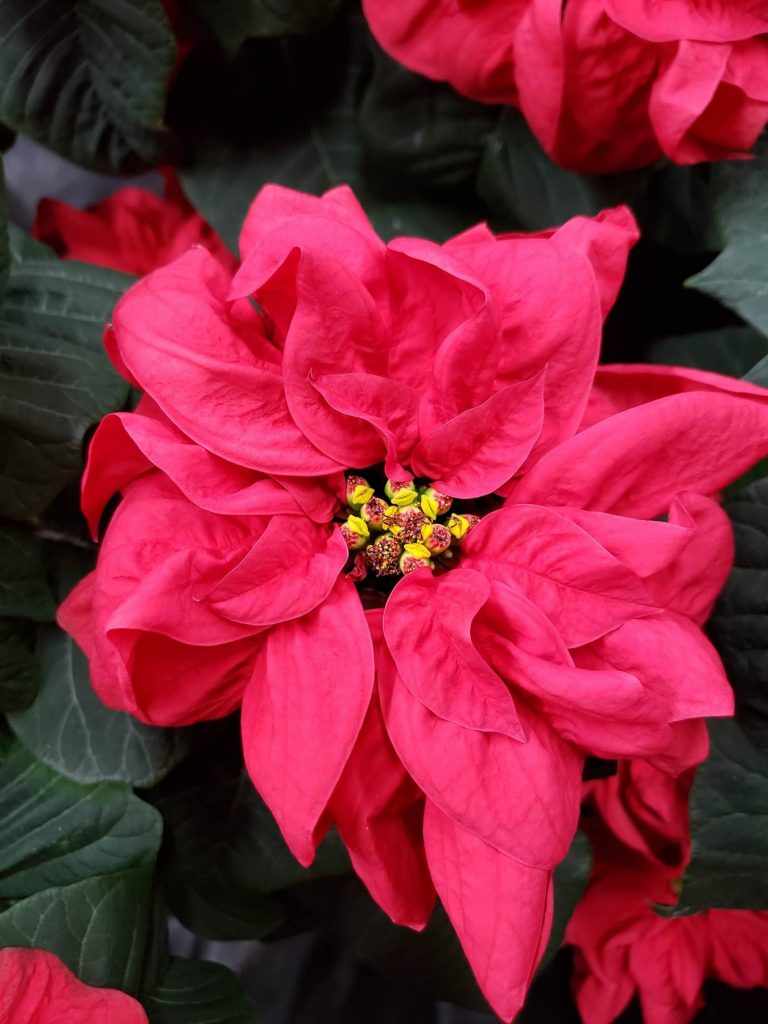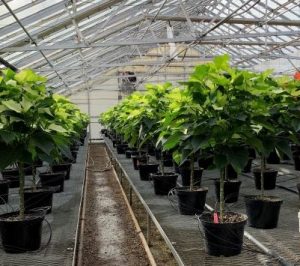Around here, November means Poinsettia season! Poinsettia care can be daunting to even the most experienced plant enthusiasts, but these showy seasonals are worth the hype! Here we’ll give you some tips to make looking after these beauties a little less stressful. We get our Poinsettias from local growers here in Illinois, but no matter where yours are from, there are some general rules of thumb when caring for Poinsettias.
Watering: Your Poinsettia should be watered from the bottom to avoid moisture on the leaves, as this causes unsightly spotting on foliage.
Often times, overwatering and underwatering your plants show similar symptoms, and the same is true of these. The soil of your Poinsettia should be slightly and consistently moist. These are not plants that should be allowed to dry out between waterings. You can determine whether or not your plant needs water simply by touching the soil. If the soil is wet, no further watering is necessary for the time being. If the soil is dry to the touch, it needs a drink! Another way to gauge how much moisture is being retained in the soil is by its weight. Pick up the grow pot. Does it feel heavy or light? Heavy means the soil is retaining a lot of moisture, light means the soil is missing needed moisture.
It’s also important to keep in mind that when you first get your Poinsettia to its new home, it will require more water for the first few weeks while it acclimates to its new environment.
Temperature: Poinsettias are native to Mexico, which means they do not tolerate the cold. Keep them away from cold temperatures and drafts. Dark, almost blackened foliage, is a sign of cold damage.
Light: Poinsettias need a minimum of six hours of bright, indirect light per day. Direct sunlight will scorch the leaves of your Poinsettia, so be on the lookout for crispy, darkened foliage.
Also recommended, remove your plant from any of its protective covering as soon as you get it home. Poinsettias produce a gas called ethylene that will cause them to wilt if they remain in any sort of sealed plastic or paper sleeve.
The ‘Classic Red’ Poinsettia is the traditional showstopper that we all associate with the Holiday season. They can get fairly large, and used in groupings, they make quite the Christmas declaration! (Pictured above with another ivory variety)
Pictured below is a variety called ‘Winter Rose.’ Not only are these beautiful rosettes of foliage an eye-catching alternative to the traditional Poinsettia, but they are also known to hold more water than the ‘Classic Red’ Poinsettia (the same is true of pink and ivory varieties). If you’re not known for having a green thumb, this variety might be a good choice for you!

‘Winter Rose’

These will have ivory colored rosettes when they’re ready, and their bonsai look is sure to please!
Shown above is a photo taken at one of our growers. These weren’t quite ready for distribution yet, in terms of their color, but it’s a great example of the tree-like growth habit that can be achieved for a non-traditional look.
And finally, every year, the million dollar question is, “How do I get my Poinsettia to re-bloom? Can I save it for next year?” And the answer is not simple. Poinsettias only show their color under very specific and unforgiving conditions. We are so sorry to break it to you! The process involves temperature controls, light manipulation, and pinch dates (removing certain bracts at specific times) that are best left to professional growers. But if you’re excited by a challenge, this article by The Spruce has some great instructions on how to get started.
Our advice is to enjoy your Poinsettias annually and care for them as best as you can throughout the Holidays — they are such a bright symbol of joy and cheer! Hopefully these tips help you get the best results out of your time with them! Seasons Greetings!









